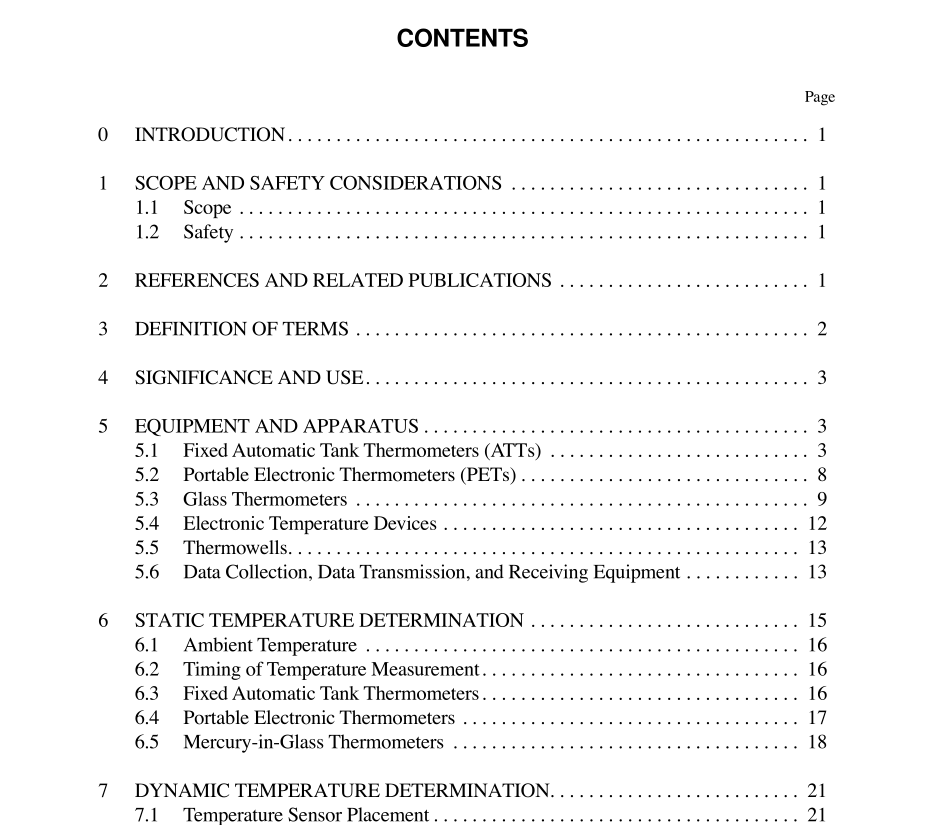API MPMS 7 pdf download

API MPMS 7 pdf download.Chapter 7—Temperature Determination
1 Scope and Safety
Considerations 1.1 SCOPE This chapter describes the methods, equipment, and proce- dures for determining the temperature of petroleum and petroleum products under both static and dynamic conditions. This chapter discusses temperature measurement require- ments in general for custody transfer, inventory control, and marine measurements. The actual method and equipment selected for temperature determination are left to the agree- ment of the parties involved. Temperatures of hydrocarbon liquids under static condi- tions can be determined by measuring the temperature of the liquid at speciÞc locations. Examples of static vessels are storage tanks, Þeld gathering tanks, ships, barges, tank cars, tank provers, and test measures. Three methods are available for determining average static tank temperatures for custody transfer. ¥ Automatic method using Þxed electronic temperature sensors. ¥ Manual method using portable electronic thermome- ters. ¥ Manual method using mercury-in-glass thermometers. The automatic method covers the determination of temper- ature using Þxed automatic tank temperature (ATT) systems for hydrocarbons having a Reid Vapor Pressure at or below 101 kPa (15 pounds per square inch absolute). ATT systems include precision temperature sensors, Þeld-mounted trans- mitters for electronic signal transmission, and readout equip- ment. The manual method covers: ¥ nonpressurized tanks and marine vessels ¥ blanketed tanks and marine vessels ¥ tanks and marine vessels that have been made inert and are under pressures of less than 21 kPa (3 pounds per square inch gauge) It does not cover hydrocarbons under pressures in excess of 21 kPa (3 pounds per square inch gauge) or cryogenic tem-perature measurement, unless the tank is equipped with a thermowell . Temperatures of hydrocarbon liquids under dynamic con- ditions can be determined by measuring the temperature of the liquid as it is ßowing through a pipe. Dynamic tempera- ture can be determined automatically or manually using elec- tronic temperature devices or mercury-in-glass thermometers. The use of thermowells may be required in dynamic measure- ment to isolate the liquid material from the temperature sen- sor. The requirements of this chapter are based on practices for crude oils and petroleum products covered by API MPMS Chapter 11.1 (ASTM D 1250). Requirements in this chapter may be used for other ßuids and other applications. However, other applications may require different performance and installation speciÞcations.
3 Definition of Terms
Terms used in this chapter are deÞned as follows: 3.1 automatic tank thermometers (ATTs): Instru- ments that continuously measure temperature in storage tanks. An ATT (also known as an automatic tank temperature system) typically includes precision temperature sensors, Þeld mounted transmitters for electronic signal transmission, and receiving/readout device(s). ¥ single-point (spot) ATT: Measures the temperature at a particular point in a storage tank where the spot temperature element is located. ¥ multiple-spot ATT: Consists of multiple (usually three or more) spot temperature elements to measure the temperature(s) at selected liquid levels in a storage tank. The readout equipment averages the submerged temperature elements to compute the average tempera- ture of the liquid in the tank. The readout equipment may also display the temperature proÞle in the tank. ¥ averaging ATT: An averaging ATT may be of the fol- lowing types: 1. A multiple-spot ATT. The readout equipment selects the individual, spot temperature element(s) that are submerged in the liquid to determine the average temperature of the liquid in the tank. 2. A variable length ATT. These ATTs consist of sev- eral temperature elements of varying length. All elements extend upwards from a position close to the bottom of the tank. The readout equipment selects the longest, completely submerged tempera- ture element to determine the average temperature of the liquid in the tank. 3.2 Celsius scale (°C): A temperature scale with the ice point of water at 0¡ and the boiling point of water at 100¡. The Celsius scale (¡C) is the international name for the centi- grade scale. [¡C = 5/9 (¡F Ð 32)]. 3.3 complete-immersion thermometer: A thermome- ter designed to indicate temperatures correctly when the entire thermometer is exposed to the temperature being mea- sured. No ASTM thermometer is designed to be used at com- plete immersion. 3.4 discrimination: The ability to sense and record the actual temperature of a liquid to the speciÞed temperature increments. 3.5 Fahrenheit scale: A temperature scale on which the freezing point of water is 32¡ and the boiling point 212¡, both at standard pressure. [¡F = 9/5¡C + 32]. 3.6 field standard test measure: A portable certiÞed vessel which is primarily used for the purpose of prover water draw calibrations.









